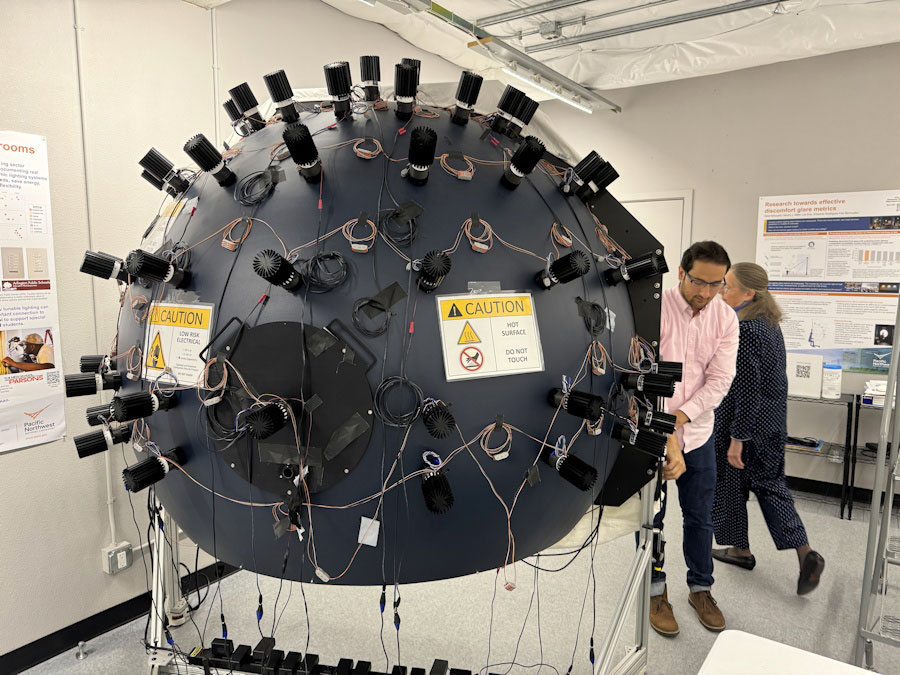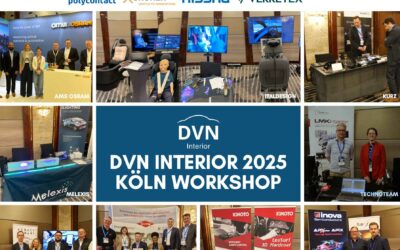By Daniel Stern, DVN Chief Editor
Naomi Miller, a Senior Scientist at the U.S. Pacific Northwest National Laboratory in Portland, Oregon, specializes in aspects of illumination including glare and TLM—temporal light modulation, commonly called “flicker”. She gave a keynote speech at the 2023 US DVN Workshop (slides available as the second item on this page), and this past Summer we reported on the early stages of research into how TLM can have seriously negative effects on roadway safety and wellbeing for drivers and their more-vulnerable fellow traffic participants, such as cyclists and pedestrians.
TLM is a new item on the list of potentially troublesome effects of vehicle lamps and lights. It has grown relevant as solid-state lighting—LEDs and OLEDs in all their forms—have supplanted the glowing filaments and arcs of past vehicle light sources. Until that happened, the lamps on a vehicle were fed with steady direct current, which was more or less constant; it did not oscillate at speeds that could cause flicker. Most of today’s vehicle lamps, on the other hand, are powered with pulse width modulation: a rapid series of brief power pulses.
Unlike past light sources, LEDs react immediately to the onset or cessation of power, no matter how fast or brief the pulses might be. So, pulsating input power results in pulsating output from it; that is flicker that is visible, or at least measurable. Often the flicker isn’t visible to an observer looking directly at the lamp, particularly when the vehicle and the observer are standing still. But when they are in motion relative to each other, the flicker can be quite pronounced.
The main relevant manifestation of TLM in the vehicle context is the Phantom Array Effect, also called the Bead Effect because the lamp, as it moves across a person’s visual field, appears not as a solid line (like past light sources did) but as a string of light-beads. This can degrade a person’s ability to get a reliable fix on the lamp’s position by following its trails within their field of view. Since driving safely requires keeping constant track of the position of other vehicles, this represents a potential safety detriment.
Too, the eye is involuntarily drawn to whatever especially salient thing might enter our view. If the item attracting a person’s gaze is a flickering, high-luminance light, their involuntary stare at it can worsen the glare effect (and if that light’s spectrum is rich in blue, that makes the discomfort glare much worse for any given level of intensity).
All of those effects are more or less universal, but TLM poses an even bigger hazard to those individuals especially sensitive to it. such people experience aggravated distraction and other cognitive disruption as well as significant disorientation, headache, nausea, fatigue, and migraines, as a reaction to amounts of TLM not perceptible (or not bothersome) to others.
Research recently carried out at PNNL has found that earlier examinations of TLM in vehicle lights might have improperly characterized and/or underestimated its threats to roadway safety, and that the recommendations for TLM mitigation springing from those earlier examinations may also be misguided and ineffective. Moreover, TLM from vehicle lamps can interfere with the performance and accuracy of machine vision systems used in ADAS and AD systems.
During my visit to PNNL, I saw a variety of intriguing experiments and trials under way. Most of them involved unique equipment and facilities. For example, the lab has a room with highly specialized LED overhead lighting. What look like ordinary white-LED office lighting panels built into the ceiling are in fact controllable to produce whatever spectrum might be desired. This allows to study the effects of various wavelengths (colours of light) on wellbeing, cognition, attention, alertness, and more.
A great deal of colour-rendering experimentation has been done in this room, and there have been some fascinating findings. For example: common wisdom that increasing the blue content of a white light’s spectrum makes the light seem brighter might not be quite right, or at least not quite so simple. In this spectrum-tunable room, it’s been found that adding red makes white light seem brighter. I got to experience this for myself: the room is full of colourful items like candy packages, colour-coded file folders, and fruit.
When the red was increased in the room light spectrum, white items still looked the same as before, but coloured items suddenly popped with increased vividness and—yes—everything looked markedly brighter. Not just red and orange items, either; even blues and greens, yellows and browns looked brighter (it is worth noting that many commercial white LEDs are deficient in red). More, there was a very curious experience involved, so unusual that it is difficult to describe accurately: it is not that I saw a red flash when the red was switched on; rather, I felt a red flash. The effect was quite prominent and, as I say, very difficult to describe in a way that makes sense to someone who has not experienced it.
Here is a video going back and forth between high and low levels of red. It is not as good as being there in person, but the effect can still be seen:
In another part of the lab, there was a sphere dotted with individually-controllable lights spaced at uniform intervals:

There is an opening for an observer’s face, with a chin rest arrangement much like one finds in the office of an ophthalmologist or optometrist. This apparatus is used for (among other things) experiments looking at glare as related to the intensity and angle of a light source:

Still another area of the lab contained an adjustable “uniformity array” consisting of a grid of LEDs which can selectively be brightened, dimmed, masked, and the grid of LEDs made to appear more dotty or more uniform/diffuse:

At the other end of a corridor from it, study participants assess brightness, glare, and other aspects of the light:

Naomi Miller kindly answered DVN’s questions about her work:
DVN: What have you found in terms of the main ways TLM (flicker) affects human and machine vision?
Naomi Miller: Human health is the greatest concern. Distraction, nausea, headache, migraine, disorientation for people. For machine vision, the frequency of the camera capture often interacts with the frequency of the TLM from the taillight or traffic signal light and may produce delayed or missed critical information for the car or device.
DVN: What do you think are the biggest misunderstandings about TLM among the general public?
N.M.: Many people do not see TLM at all. Or if they do, they do not perceive it as a problem, so they dismiss the complaints about TLM as frivolous or overblown. It’s a little like peanut allergies, which can be deadly serious; Those who don’t have a peanut allergy (aren’t sensitive to TLM), might think the person who asks that peanuts not be served on the airplane (objects to light flicker) is just being a pain in the neck, and that they should just get over it. That isn’t how it works!
DVN: Aside from vision, how else are humans affected by TLM, and what do you think are the major implications?
N.M.: Non-visual responses to TLM are real. They include disorientation, because the light patterns produced by the phantom array effect can give an observer a distorted or inaccurate idea of where a lighted object is moving from and to. The retinal light pattern suggests the object is moving in a direction other than it really is, or that it is jumping around, because the light is not continuous. Also, light can enter the eye through the eyelid or through an indirect, glancing blow to the cornea. Many people sense the light even though it is not directly imaged on the retina. Sneaky stuff, that light!
DVN: What aspects and effects of TLM do traffic participants have to be concerned about — drivers, passengers, pedestrians, cyclists?
N.M.: There’s the distraction of TLM pulling attention away from the most important elements on the roadway. There’s the misinterpreted movement of a car or bicycle, there’s the nausea that the instrument panel [or other displays] may produce for a driver or passenger. These can be issues without the observer recognizing what the cause is.
DVN: During my visit, you mentioned equipment upgrades and new glare research. Can you elaborate?
N.M.: We have a new LED board installed in the uniformity apparatus, and we are studying how the pattern and spacing of LEDs in the visual field (like in a headlight) affect the perception of glare. We are early in this work, but it may help explain why so many people are complaining about increased glare from LEDs, and the frightening loss of visibility at night that it produces. It looks like LEDs spaced close together may be producing a greater perceived glare response than normal glare science would predict. That may help explain why headlights feel so bright.
DVN: Are there traffic- and safety-relevant matters related to TLM that aren’t presently being looked at, that you think should be?
N.M.: Gosh, yes! Glare, health issues, comfort issues, visibility at night, safety; these are all affected by LEDs used on roadways and in vehicles—day and night. The degree and nature of the effects are affected by the electronics that drive the LEDs and their waveforms. We know far too little yet, but manufacturers need to be aware they may be introducing new hazards into the driving environment.
_________
It is increasingly apparent that the problems caused to human beings by TLM (like those caused by blue light, also a research topic) are bigger and more serious than just an annoyance. Contrary to existing practice, a quick and easy fix doesn’t apply. The assumption, including in our vehicle lighting world, has been that it’s sufficient to just avoid PWM frequencies that produce obviously visible flicker—the common wisdom has been ‘keep it above 200 Hz and it’ll be fine’. But PNNL’s deep and broad research is revealing that bad effects persist well beyond readily-visible flicker; they can be avoided only by eliminating TLM altogether, or at least dramatically reducing its amplitude.
This will mean using techniques other than PWM to control solid-state light sources. It might be hard to quit such an addictively lovable strategy as PWM, which offers easy, inexpensive control over effective output of LEDs and OLEDs, but it surely won’t be the first such difficult breakup. The history of industry and science is full of eventually learning deleterious effects of a strategy or technique spoil what previously seemed like a lopsidedly favourable cost-benefit ratio. Leaded gasoline comes to mind, or the use of mercury and asbestos. The question eventually comes down to whether industry will responsibly acknowledge and address the matter, or wait until regulations force the cleanup to be done in more costly and burdensome ways.
PNNL’s ongoing research will surely be of keen interest to all of us whose work involves the interaction of humans and light!






